Impact of the Introduction of Biofuel in the Transportation Sector in Indonesia
Abstract
:1. Introduction
- What is the potential in volume of biofuel production in Indonesia and under which conditions?
- What is the impact of the introduction of biofuel on the energy balance in Indonesia? What is its economic value and labor requirement?
- By how much can emission of greenhouse gases be reduced? What is the technology to assess biofuel development in Indonesia?
2. Energy Policies in Indonesia
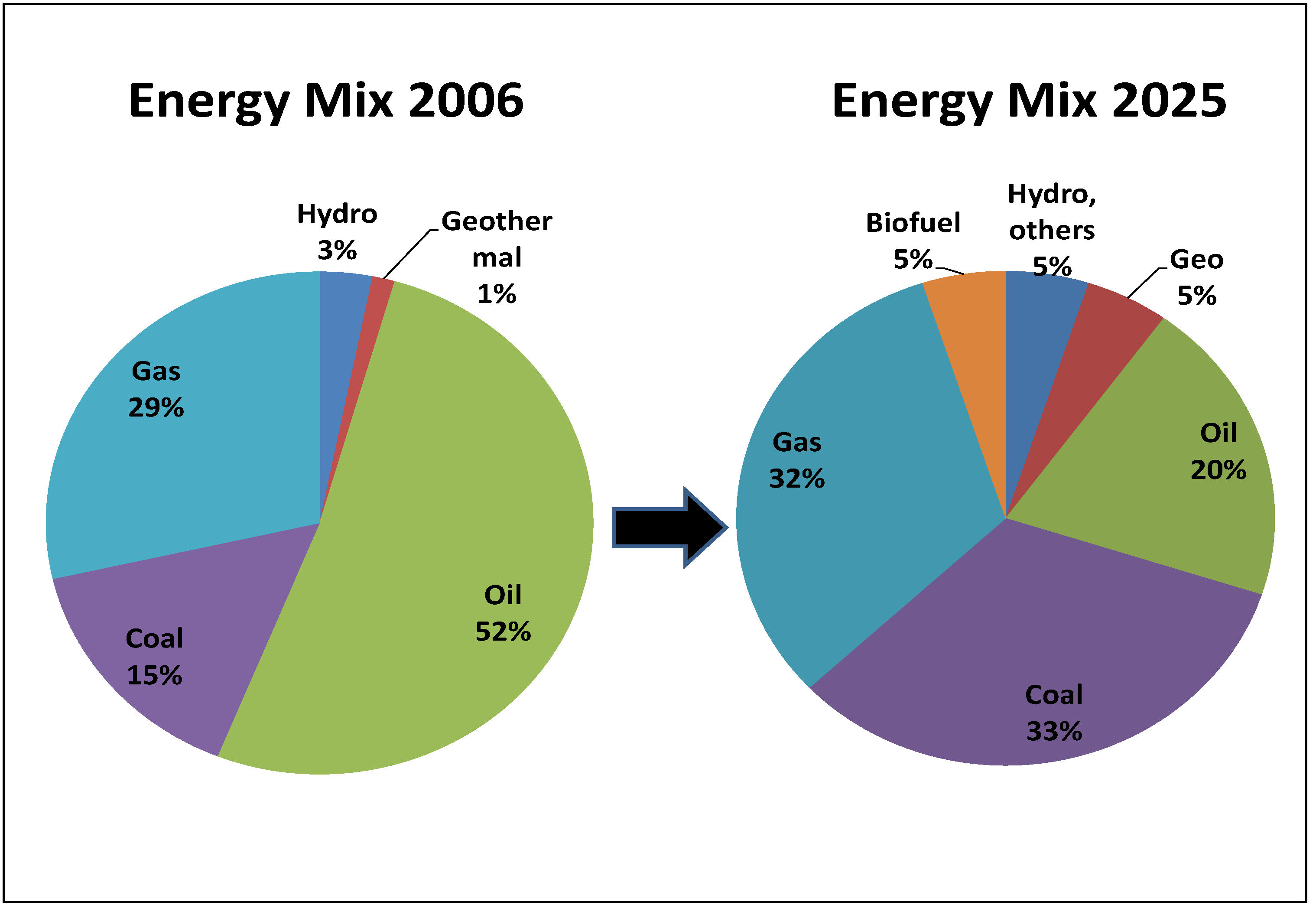
| 2000 | 2002 | 2004 | 2006 | 2008 | Growth (%) | |
|---|---|---|---|---|---|---|
| Gasoline | 10.6 | 11.9 | 14.6 | 14.6 | 17.2 | 7.43 |
| Diesel fuel | 8.4 | 8.8 | 9.7 | 7.9 | 7.9 | –0.74 |
| Others (biofuel) | n/a | n/a | n/a | 0.2 | 0.9 | 116.67 |
| Total Transportation | 19.0 | 20.7 | 24.3 | 23.2 | 26.1 | 4.68 |
| Final Energy Consumption | 63.9 | 65.6 | 73.0 | 72.0 | 87.8 | 4.68 |
3. Tools and Methods
3.1. Model Description
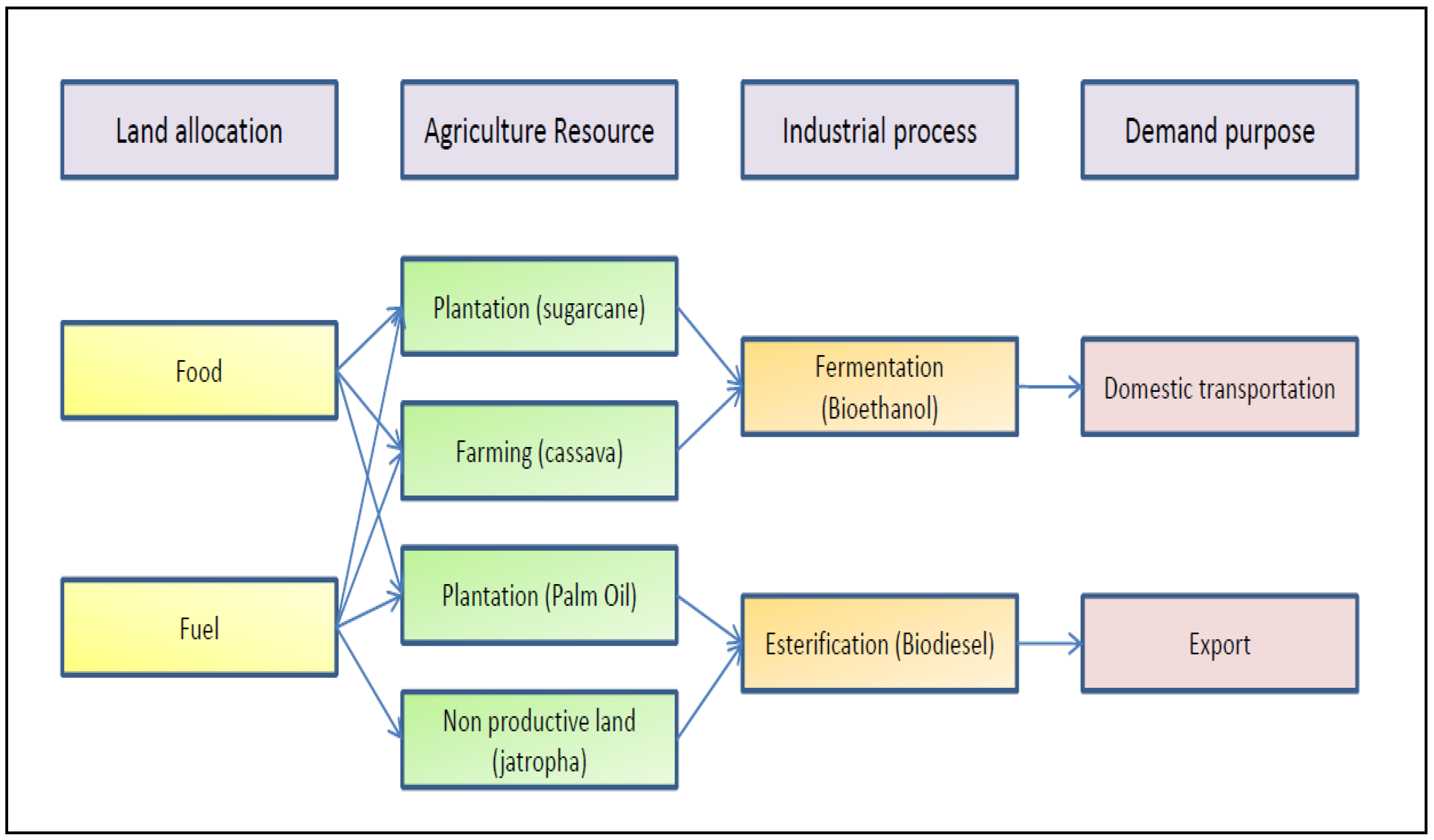
3.2. Basic Equations of the BIOFUEL Model














3.3. Input Parameters
| Sugarcane | Cassava | Palm oil | Jathropha | |
|---|---|---|---|---|
| Energy (MJ/L) a | ||||
| agriculture | 3 | 3.91 | 6.56 | 13.23 |
| industrial | 3.34 | 8.15 | 7.3 | 26.46 |
| output | 31.22 | 34.4 | 49.54 | 60.85 |
| Cost (USD/L) b | ||||
| agriculture | 0.324 | 0.276 | 0.328 | 0.384 |
| industrial | 0.216 | 0.184 | 0.082 | 0.096 |
| Emission (kgCO2eq/L) c | ||||
| agriculture | 0.21 | 0.253 | 0.748 | 0.635 |
| industrial | 0.226 | 0.711 | 0.15 | 2.54 |
| avoid | 2.323 | 2.597 | 2.8 | 3.613 |
| Yield d | ||||
| agriculture (ton/ha) | 70 | 40 | 18 | 2 |
| industrial (L/ton) | 70 | 150 | 230 | 189 |
| Land a | Sugarcane | Cassava | Palm oil | Jatropha |
|---|---|---|---|---|
| size (106 ha) | 0.35 | 1.1 | 5.5 | 0.06 |
| fuel part (%) | 8.57 | 8.33 | 5.45 | 100 |
| fuel growth/year (%) | 27.02 | 17.27 | 16.46 | 25.88 |
| Constraints | Gasoline | Diesel | Bioethanol | Biodiesel |
| Energy content (MJ/L) d | 32 | 36.4 | 21.1 | 34.5 |
| Yield growth rate/annum (%)b | ||||
| agriculture | 1.9721 | 2.36652 | ||
| industrial | 1.9887 | 2.3864 | ||
| Demand c | ||||
| domestic (103 l) | 82,500 | 590,000 | ||
| growth/annum (%) | 33.795 | 10.4 | ||
| Employees e | ||||
| agriculture (person/ha) | 0.64 | 0.64 | ||
| industrial (person/106 l) | 1.04 | 6.08 |
3.4. Scenario Setting
4. Results and Analysis
4.1. Resource Production Potential
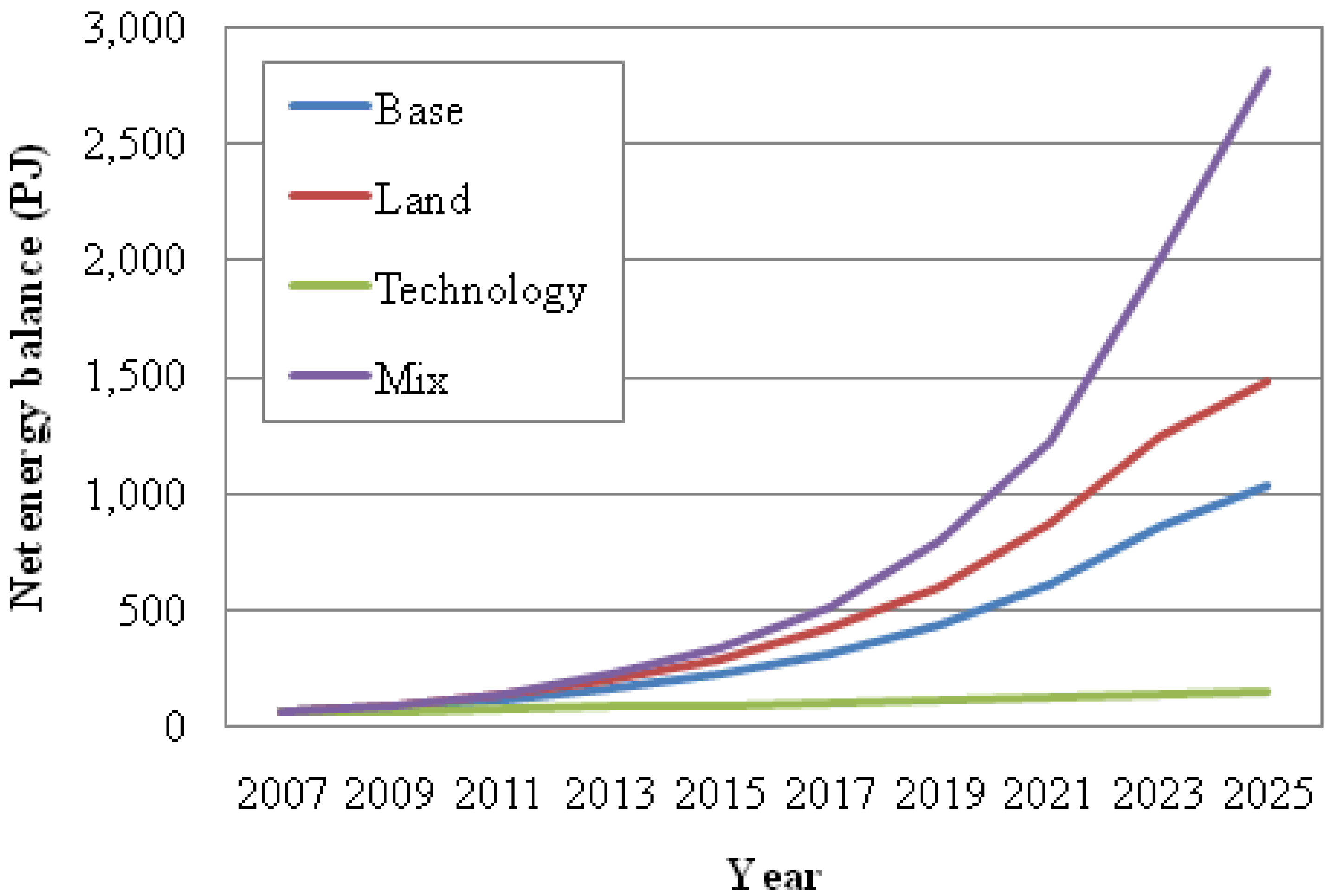
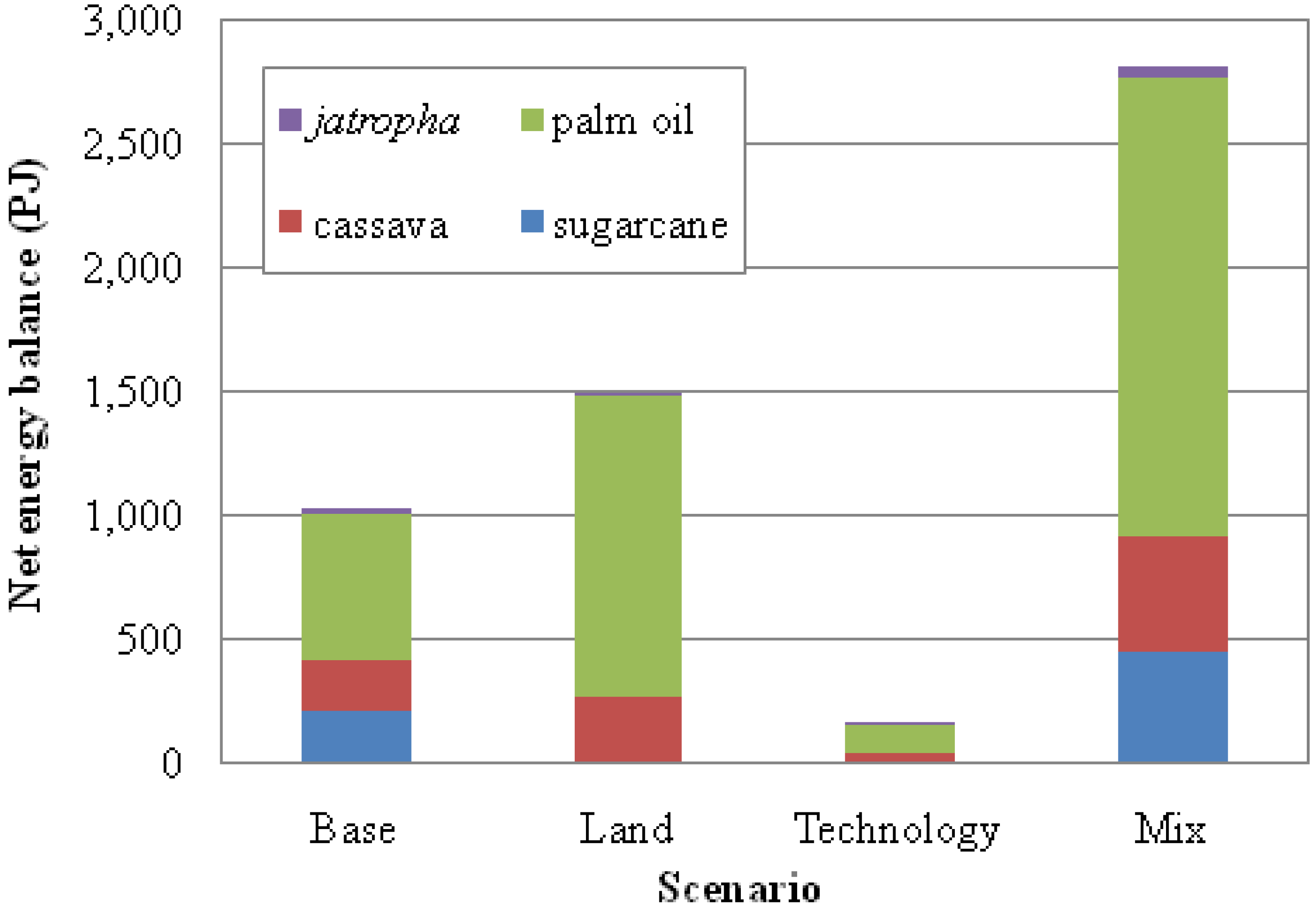
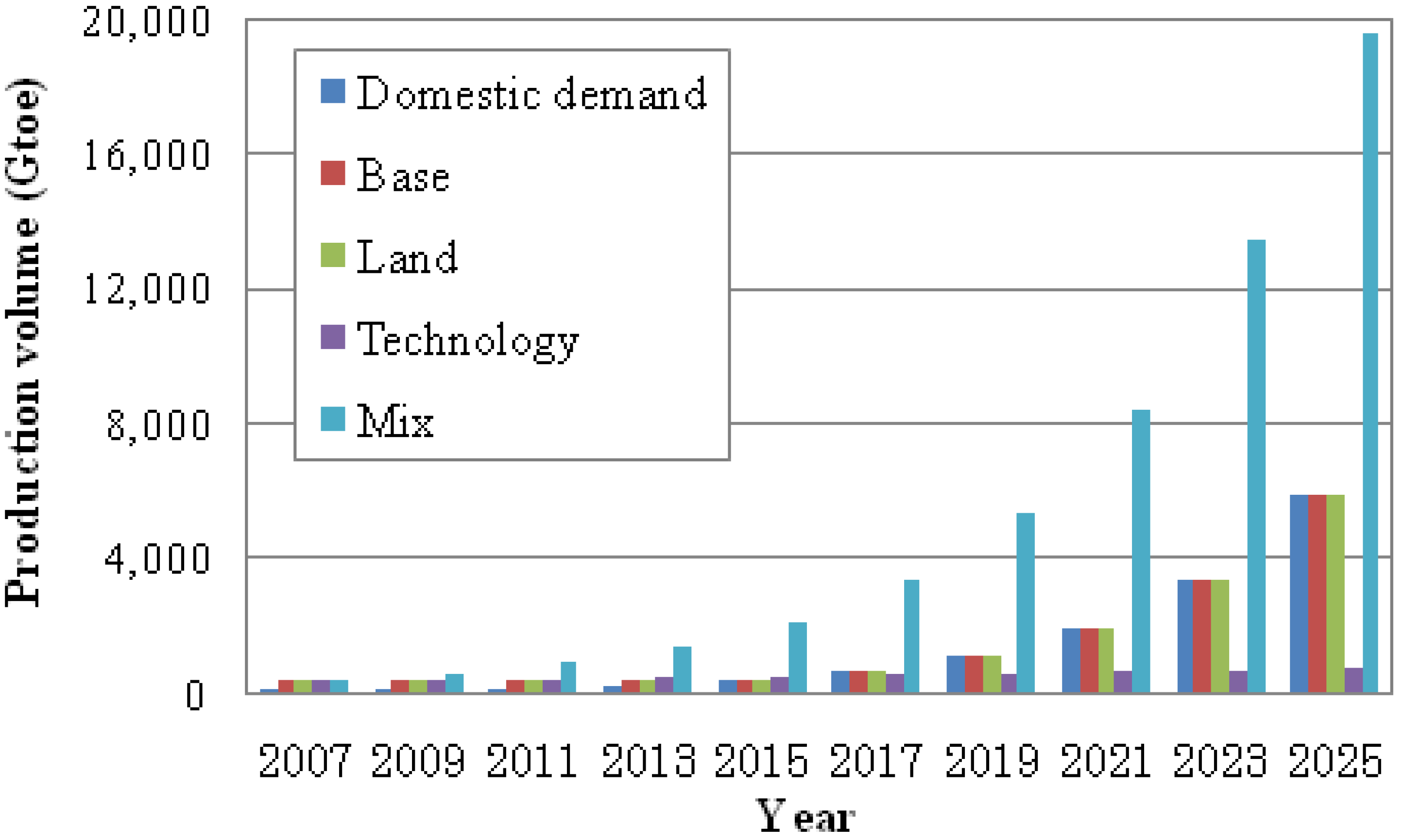
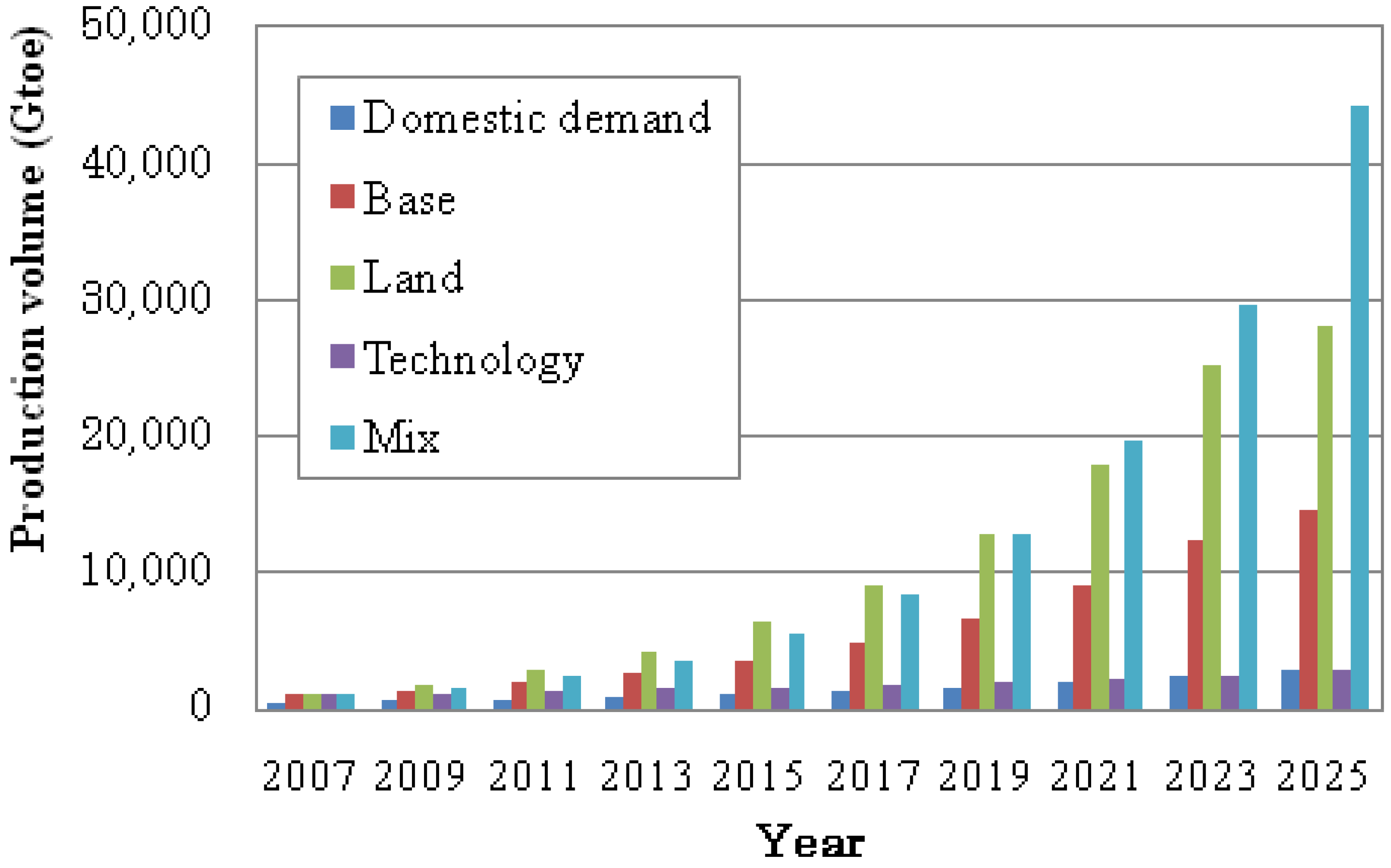
4.2. Economic Impact Assessment
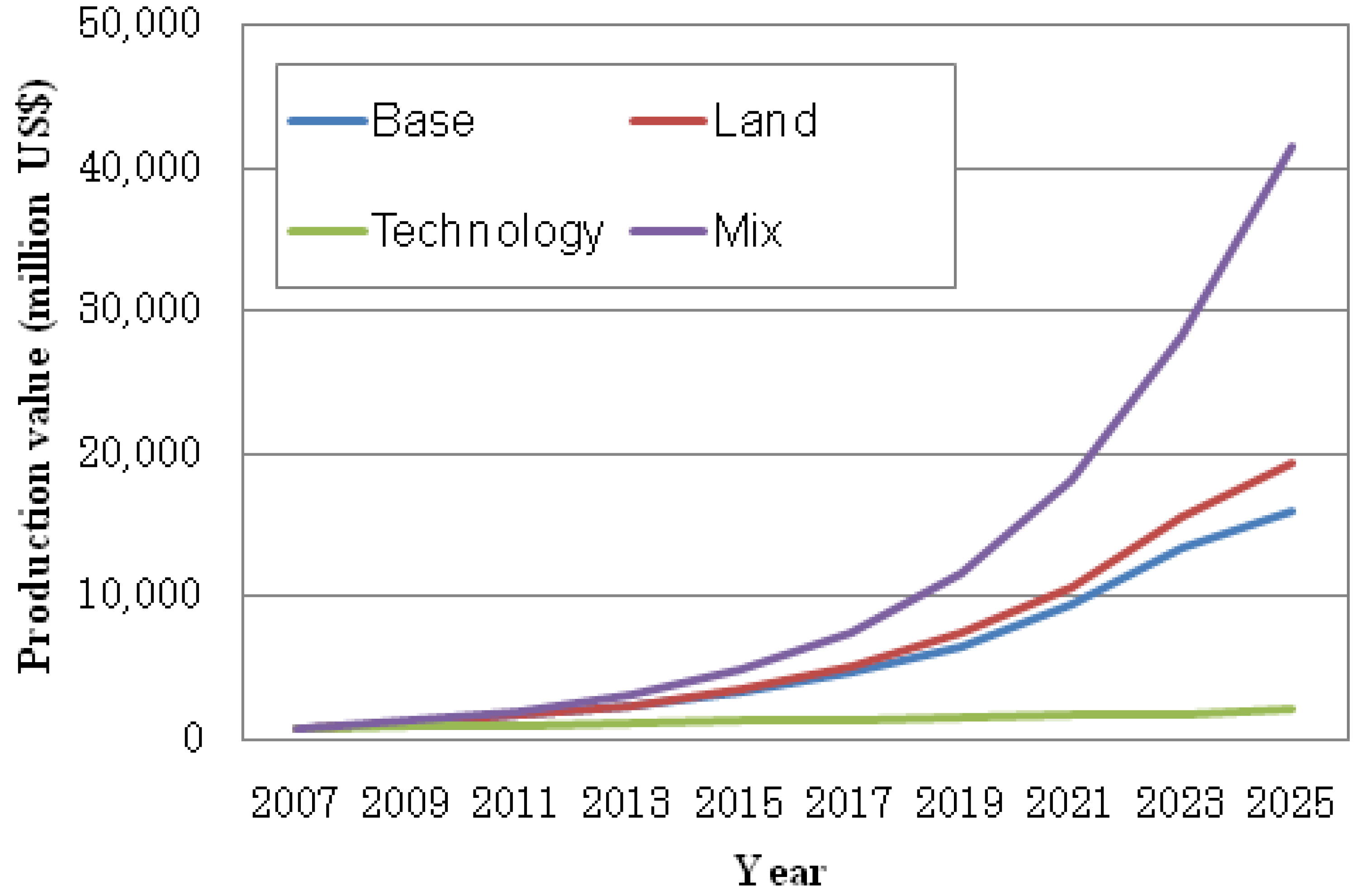
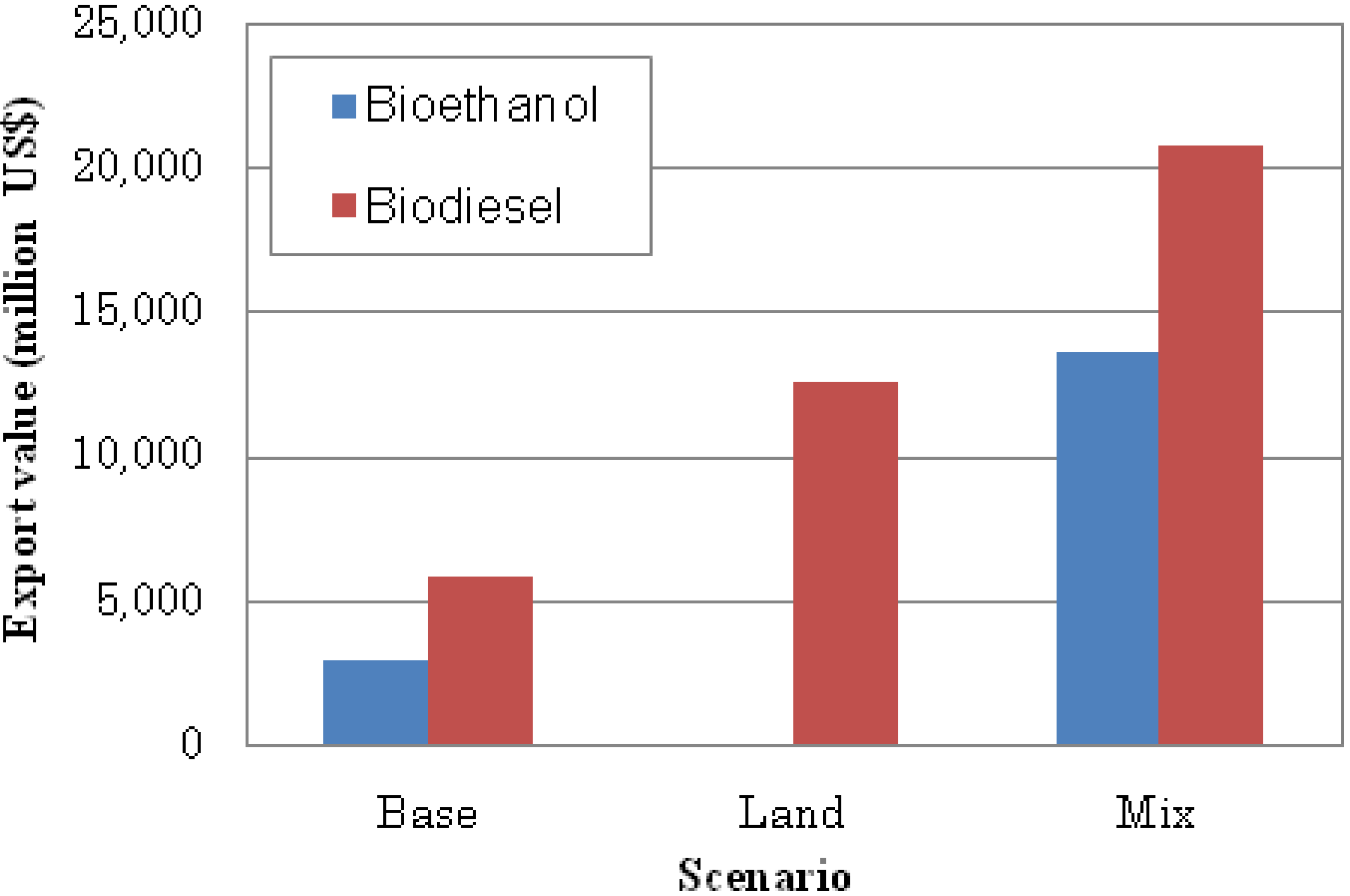
| Scenario | Labor (people) |
|---|---|
| Base | 6,897,755 |
| Land | 6,941,960 |
| Technology | 343,205 |
| Mix | 7,140,516 |
4.3. Environment Impact Assessment
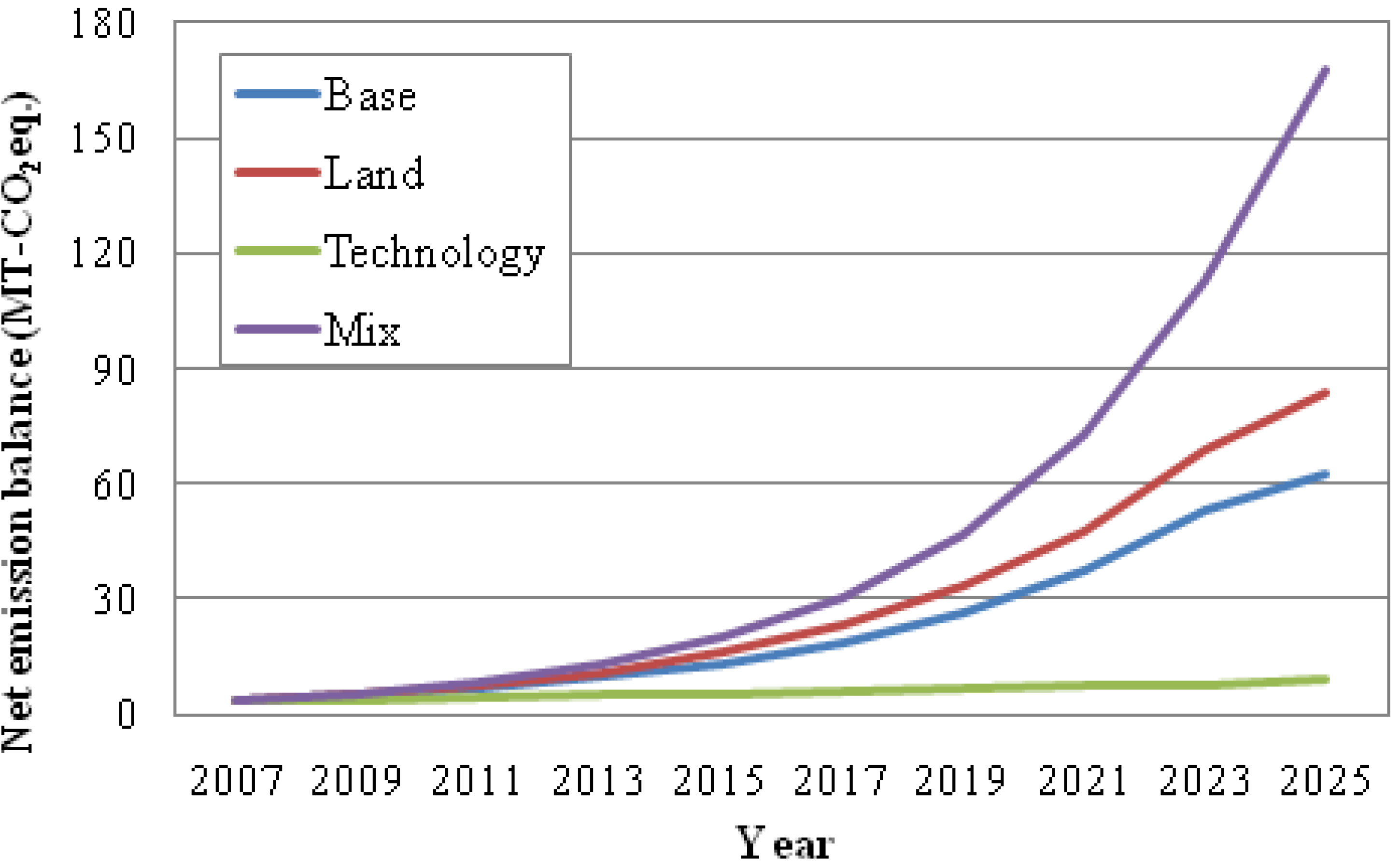
4.4. Technology Assessment
4.5. Limit of the Model
5. Conclusions
- -
- reduce the dependency on oil by partially replacing the fuel demand for domestic transportation;
- -
- empower local communities by creating jobs in agriculture and the industrial sector;
- -
- generate income by exporting excess production;
- -
- and lead to positive carbon saving emissions.
- The maximum net energy balance is achieved in the ‘mix’ scenario, at 2.8 × 103 PJ, and the minimum net energy balance is achieved in the ‘technology’ scenario at 155 PJ.
- The energy output in the ‘technology’ scenario, which relies on technology improvement without land expansion, can only fulfill domestic demand for bioethanol and biodiesel up to 2015 and 2023, respectively.
- The economic perspectives, at an oil price of 60 USD/barrel, are that replacement of oil by biofuel in domestic transportation could save 4.14 billion USD in 2025. In the combined export and domestic usage, biofuel could save up to 29 billion USD by 2025.
- In all scenarios, the highest export value of 34 billion USD in 2025 is achieved in the ‘mix’ scenario. The ‘technology’ scenario does not create export value in 2025, as it cannot even fulfill domestic demand. This indicates that technological development alone is able to fulfill the domestic demand up to 2023, and later on, will not able to generate income from export, starting from 2025.
- The introduction of biofuel in Indonesia could create around 7 × 106 jobs in 2025, in all but the ‘technology’ scenario. The ‘technology’ scenario does not show a high increment in job creation as the creation in this scenario only relies on the yield of products and not on the labor created by increased allocation of land.
- Under sustainable production, a carbon saving could be achieved of up to 168 × 106 ton CO2 equivalent in 2025 in the ‘mix’ scenario. In the other scenarios, only 6%, 28%, and 50% of this value will be achieved in the ‘technology’, ‘base’, and ‘land’ scenarios, respectively.
- The production costs may decrease, due to economies of scale; the production output could increase due to technological development, leading to an increasing yield of products in agricultural and industrial processes.
- The development of biofuel production in Indonesia is still in its infancy. The potential of its development must be carefully assessed by considering all related parties: the biofuel industries, the workers, local communities, and government as policy makers. Involving the local communities by hiring and training local people to plant biofuel crops in as sustainable way and buying the crops from local farmers could be an option for the biofuel industry.
Nomenclature
| Sets | |
| i | Crops (1 = sugarcane, 2 = cassava, 3 = palm oil, 4 = Jatropha) |
| j | Supply (1 = food, 2 = fuel) |
| k | Fuels (1 = ethanol, 2 = biodiesel) |
| t | Period (0 = 2007,1 = 2009,…,9 = 2025) |
| Parameters | |
| C i Agr | Cost in agriculture sector of i crops (US$/L) |
| C i Ind | Cost in industry sector of i crops (US$/L) |
| D k, o Dom | Biofuel domestic demand of k fuel at 2007 (liters) |
| Em i Agr | Emission in agriculture sector of i crops (kgCO2eq/L) |
| Em i Ind | Emission in industrial sector of i crops (kgCO2eq/L) |
| Em i Avoid | Emission avoided of i crops (kgCO2eq/L) |
| En i Agr | Energy input agriculture of i crops (MJ/L) |
| En i Ind | Energy input industry of i crops (MJ/L) |
| En i Out | Energy output of i crops (MJ/L) |
| Eq k | Volume equivalent of k fuel with oil (toe/103L biofuel) |
| L i, o | Land allocation of i crops at 2007 (ha) |
| O i | Oil equivalent of i crops (toe) |
| Pi Agr | Labor in agriculture sector of i crops (person/ha) |
| Pi Ind | Labor in industrial sector of i crops (person/L) |
| Si,0 Food | Land share for food of i crops at 2007 |
| Si,0 Fuel | Land share for fuel of i crops at 2007 |
| Yi ,0 Agr | Yield of agriculture product of i crops at 2007 (t/ha) |
| Yi, 0, Ind | Yield of industrial product of i crops at 2007 (L/t) |
| dk Dom | Growth rate of domestic biofuel demand of k fuels (%) |
| ji Agr | Job in agriculture sector (person/ha) |
| jk Ind | Job in industrial sector (person/L) |
| li Food | Land allocation growth rate for food of i crops (%) |
| li Fuel | Land allocation growth rate for fuel of i crops (%) |
| ri Agr | Growth rate of agriculture product of i crops (%) |
| rk Ind | Growth rate of industrial product of k fuels (%) |
| Variables | |
| CB t | Total production cost at time t (US$) |
| D i,t Food | Food demand of i crops at time t (ton) |
| D k,t Dom | Fuel domestic demand of k fuel at time t (L) |
| D k,t Exp | Fuel export demand of k fuel at time t (L) |
| EB t | Total energy balance at time t (MJ) |
| EmB t | Total emission balance at time t (kg CO2Equation) |
| F i,t, | Fuel output of i crops at time t (L) |
| Ji,t | Total job created of i crops at time t (person) |
| L i,t Food | Land allocation for food of i crops at time t (ha) |
| L i,t Fuel | Land allocation for fuel of i crops at time t (ha) |
| Pt | Total profit at time t (US$) |
Acknowledgements
References
- The State of Food and Agriculture, Biofuels: Prospects, Risks and Opportunities; FAO: Rome, Italy, 2008.
- National Team for Biofuel Development. Blueprint Biofuel Development for Poverty Alleviation and Job Creation; Indonesia Ministry of Energy and Mineral Resources: Jakarta, Indonesia, 2006. [Google Scholar]
- Creating Value for All: Strategies for Doing Business with the Poor; United Nations: New York, NY, USA, 2008.
- Indonesia: Economic and Social update April 2008; The World Bank: Washington, DC, USA, 2008.
- Handbook of Energy and Economic Statistic of Indonesia 2009; Indonesia Ministry of Energy and Mineral Resources: Jakarta, Indonesia, 2009.
- Reuter, A.; Voss, A. Tools for energy planning in developing countries. Energy 1990, 15, 705–714. [Google Scholar] [CrossRef]
- Brooke, A.; Kendrick, D.; Meeraus, A.; Raman, R. GAMS Release 23.1. A User’s Guide; GAMS Development Corp.: Washington, DC, USA, 2008. [Google Scholar]
- Macedo, I.C.; Seabra, J.E.A.; Silva, J.E.A.R. Greenhouse gases emissions in the production and use of ethanol from sugarcane in Brazil: The 2005/2006 averages and a prediction for 2020. Biomass Bioenerg. 2008, 32, 582–595. [Google Scholar] [CrossRef]
- Nguyen, T.L.T.; Gheewala, S.H.; Garivait, S. Energy balance and GHG-abatement cost of cassava utilization for fuel ethanol in Thailand. Energ. Policy 2007, 35, 4585–4596. [Google Scholar]
- Pleanjai, S.; Gheewala, S.H. Full chain energy analysis of biodiesel production from palm oil in Thailand. Appl. Energ. 2009, 86, S209–S214. [Google Scholar]
- Reindhardt, G.; Gaertner, S.; Rettenmaier, N.; Muench, J.; von Falkenstein, E. Screening Life Cycle Assessmnet of Jathropha Biodiesel; Institute for Energy and Environmental Research (IFEU): Heidelberg, Germany, 2007. [Google Scholar]
- The Future of Liquid Biofuels for APEC Economies; APEC: Singapore, 2008.
- Fargione, J.; Hill, J.; Tilman, D.; Polasky, S.; Hawthorne, P. Land clearing and the biofuel carbon debt. Science 2008, 319, 1235–1238. [Google Scholar] [CrossRef]
- Coelho, S.T.; Goldemberg, J.; Lucon, O.; Guardabassi, P. Brazilian sugarcane ethanol: Lessons learned. Energy Sustain. Dev. 2006, 10, 26–39. [Google Scholar] [CrossRef]
- Moreira, J.R.; Goldemberg, J. The alcohol program. Energ. Policy 1999, 27, 229–245. [Google Scholar] [CrossRef]
- Handbook of Energy and Economic Statistic of Indonesia 2008; Indonesia Ministry of Energy and Mineral Resources: Jakarta, Indonesia, 2008.
- ORNL Bioenergy Conversion. Available online: http://bioenergy.ornl.gov/papers/misc/energy_conv.html (accessed on 12 November 2009).
- Junginger, M.; de Visser, E.; Hjort-Gregersen, K.; Koornneef, J.; Raven, R.; Faaij, A.; Turkenburg, W. Technological learning in bioenergy systems. Energ. Policy 2006, 34, 4024–4041. [Google Scholar] [CrossRef]
- Wetland International Central Kalimantan Peatland Project. Available online: http://www.wetlands.org/ (accessed on 14 November 2009).
- Zhou, A.; Thomson, E. The development of biofuels in Asia. Appl. Energ. 2009, 86, S11–S20. [Google Scholar] [CrossRef]
- OECD-FAO. Agricultural Outlook 2008–2017; OECD, FAO: Paris, France; Rome, Italy, 2008. [Google Scholar]
© 2010 by the authors; licensee MDPI, Basel, Switzerland. This article is an Open Access article distributed under the terms and conditions of the Creative Commons Attribution license (http://creativecommons.org/licenses/by/3.0/).
Share and Cite
Jupesta, J. Impact of the Introduction of Biofuel in the Transportation Sector in Indonesia. Sustainability 2010, 2, 1831-1848. https://doi.org/10.3390/su2061831
Jupesta J. Impact of the Introduction of Biofuel in the Transportation Sector in Indonesia. Sustainability. 2010; 2(6):1831-1848. https://doi.org/10.3390/su2061831
Chicago/Turabian StyleJupesta, Joni. 2010. "Impact of the Introduction of Biofuel in the Transportation Sector in Indonesia" Sustainability 2, no. 6: 1831-1848. https://doi.org/10.3390/su2061831




